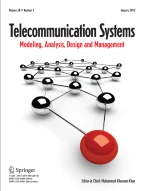Abstract
This paper proposes three different dynamic cell coordination schemes using adaptive link adaptation and variable frequency reuse for OFDMA downlink cellular networks, which are composed of greedy cell coordination for flat fading channel, dynamic maximum C/I cell coordination (DMCC), and dynamic proportional fairness cell coordination (DPFCC) for frequency selective fading channel. The performances of the proposed dynamic cell coordination schemes are compared to those with no cell coordination schemes and static reuse coordination schemes using conventional proportional fair (PF) scheduling in terms of system throughput and fairness. Simulation results demonstrate that the proposed schemes allow the radio network controller (RNC) and base stations (BSs) to apply different reuse factors on each subchannel in consideration of different interference conditions of individual users so as to increase the system throughput and guarantee QoS requirement of each user on the multicell environment, where the performance of conventional OFDMA downlinks might have become degraded due to persistent interference from other cells. In frequency flat fading, the proposed dynamic schemes achieve, on average, a 1.2 times greater system throughput than no cell coordination, a 1.4 times greater static cell coordination and a 3 times greater simplified subchannel allocation scheme (SSAS) (Kim et al. in Proceedings of IEEE VTC spring’04, vol. 3, pp. 1821–1825, 2004). In frequency selective fading, the proposed scheme, DMCC, showed a 2.6 times greater throughput than that of a single reuse factor of one for all subcarriers, and DPFCC demonstrated a single reuse factor as good as one.
Similar content being viewed by others
Explore related subjects
Discover the latest articles, news and stories from top researchers in related subjects.References
Kivanc, D., Li, G., & Liu, H. (2003). Computationally efficient bandwidth allocation and power control for OFDMA. IEEE Transactions on Communications, 2, 1150–1158.
Tse, D. (2001). Multiuser diversity in wireless networks. Wireless communication seminar, Standford University.
Wong, C. Y., & Cheng, R. S. (1999). Multiuser OFDM with adaptive subcarrier, bit, and power allocation. IEEE Journal on Selected Areas in Communications, 17, 1747–1758.
Kivanc, D., & Liu, H. (2000). Subcarrier allocation and power control for OFDMA. In Conference record of the thirty-fourth Asilomar conference on signals, systems and computers (Vol. 1, pp. 147–151).
Suzuki, M., Bohnke, R., & Sakoda, K. (1998). Band division multiple access (BDMA) system: a novel approach for next generation mobile telecommunication systems, based on OFDM and SFH-TDMA. In Proceedings of IEEE VTC 1998 (Vol. 2, pp. 1326–1330), Ottawa, Canada.
Zander, J., & Frodigh, M. (1992). Capacity allocation and channel assignment in cellular radio systems using reuse partitioning. Electronics Letters, 28(5), 438–440.
Blair, P., Polyzos, G. C., & Zorzi, M. (1998). Plane cover multiple access: A media access control strategy for wireless environments. In Proceedings of international conference on universal personal communications (ICUPC’98), Florence, Italy.
Blari, P. M., Polyzos, G. C., & Zorzi, M. (2001). Plane cover mutiple access: a new approach to maximizing cellular system capacity. IEEE Journal on Selected Areas in Commununications, 19, 2131–2141.
Kim, H., Han, Y., & Koo, J. (2004). Optimal subchannel allocation scheme in multicell OFDMA systems. In Proceedings of IEEE VTC spring’04 (Vol. 3, pp. 1821–1825), Milan, Italy.
Recommendation ITU-R M. 1225. (1997). Guideline for evaluation of radio transmission technologies for IMT-2000.
Telecommunications Technology Association (TTA). (2004). TTAR-0016, Evaluation criteria of radio access technology for 2.3 GHz portable Internet.
3GPP R1-030042. (2003). Update of OFDM SI simulation methodology.
IEEE P802.16e/D3. (2004). Draft amendment to IEEE standard for local and metropolitan area networks, part 16: air interface for fixed broadband wireless access systems—amendment for physical and medium access control layers for combined fixed and mobile operation in licensed bands.
Author information
Authors and Affiliations
Corresponding author
Rights and permissions
About this article
Cite this article
Byun, D.W., Ki, Y.M. & Kim, D.K. Channel state-aware joint dynamic cell coordination scheme using adaptive modulation and variable reuse factor in OFDMA downlink. Telecommun Syst 36, 85–96 (2007). https://doi.org/10.1007/s11235-007-9060-2
Published:
Issue Date:
DOI: https://doi.org/10.1007/s11235-007-9060-2
